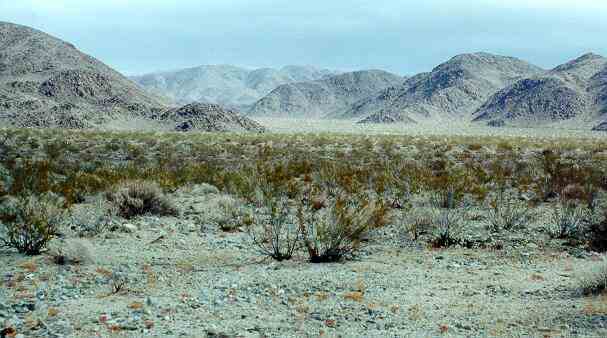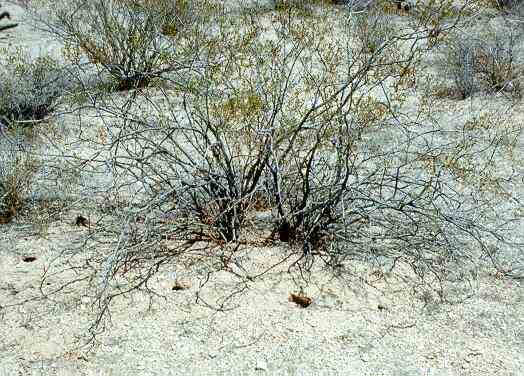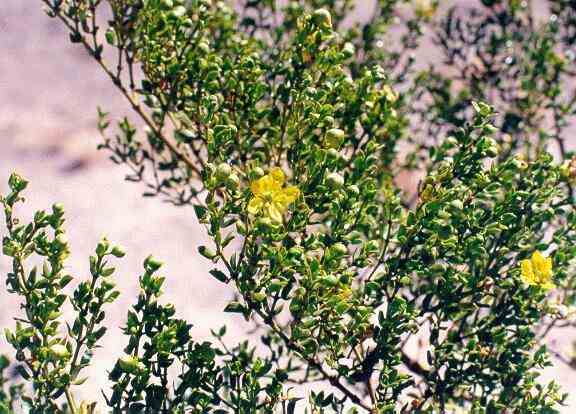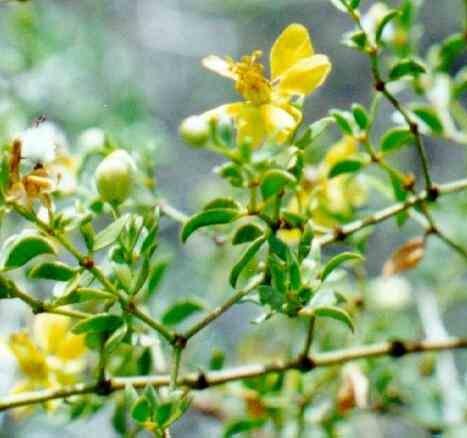| CREOSOTE BUSH (Larrea
tridentata) This
is one of the most common and characteristic desert
plants, occurring as almost pure stands over large areas
of land in the hot deserts of North America.

Extensive area of creosote bush experiencing extreme
drought

Close-up of one of these plants, showing
that most of the leaves have died. Note the presence of
many holes made by burrowing animals (kangaroo rats and
other rodents) in the soil round the base of the plant.
Most of the desert animals shelter in these underground
burrows during the heat of the day and emerge to forage
at night.

Creosote bush in a period of abundant
water availability - note the many small, resin-coated
leaves and the many flowers or flower buds.

Close-up of leaves and flowers (with five
bright-yellow sepals (not petals), twisted like the
blades of a fan).
Details
Distribution: widespread in hot
deserts, often in almost pure stands over several
hectares.
Plant size: typically up to 1 metre, the
plants being evenly spaced (probably due to competition
for water, but possibly because the roots exude
allelochemicals which inhibit the growth of other
plants). Individual plants can live for up to 200 years,
producing new stems from below soil level.
Leaves: small, consisting of two
leaflets, joined at the base (like the foot of a deer).
They have a thick, glossy cuticle to withstand water
loss. They persist throughout the dry periods, but turn
brown and eventually die in prolonged droughts. They
contain resins, and smell like creosote when crushed.
Flowers: five bright-yellow sepals (not
petals), twisted like the blades of a fan
Fruit: small, globose and covered in
hairs.
The creosote bush thrives on well-drained areas of
flat or sloping land - often with an underlying compacted
soil layer of calcium (called caliche). Beneath
the gravelly surface the soil consists of tightly packed
sand and silt particles, with very little organic matter.
These soils do not retain much water. pH is alkaline
(inhibitory to most plants) and the annual rainfall is
less than 25 cm. Almost all this rain falls as short,
intense showers. The surface soil quickly becomes
saturated by rain, and the packed soil particles prevent
rapid water penetration, so much of the water runs off of
the surface in flash floods. As a consequence, the only
permanent plants (such as creosote bush) are those with
extensive and deep root systems and with special
adaptations to survive long periods of intense heat and
drought.
The leaves of creosote bush contain anti-herbivory
resinous compounds, so the plant is seldom eaten by
grazing animals.
Go to:
|



